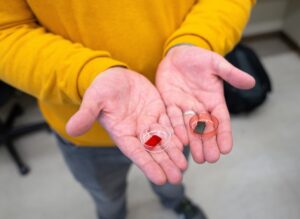
California’s Silicon Valley and Utah’s Silicon Slopes are named for the element most associated with semiconductors, the backbone of the computer revolution. Anything computerized or electronic depends on semiconductors, a substance with properties that conduct electrical current under certain conditions. Traditional semiconductors are made from inorganic materials—like silicon—that require vast amounts of water and energy to produce.
For years, scientists have tried to make environmentally friendly alternatives using organic materials, such as polymers. Polymers are formed by linking small molecules together to make long chains. The polymerization process avoids many of the energy-intensive steps required in traditional semiconductor manufacturing and uses far less water and fewer gasses and chemicals. They’re also cheap to make and would enable flexible electronics, wearable sensors and biocompatible devices that could be introduced inside the body. The problem is that their conductivity, while good, is not as high as their inorganic counterparts.
All electronic materials require doping, a method of infusing molecules into semiconductors to boost conductivity. Scientists use molecules, called dopants, to define the conductive parts of electrical circuits. Doping in organic materials has vexed scientists because of a lack of consistency—sometimes dopants improve conductivity while other times they make it worse. In a new study, researchers from the University of Utah and University of Massachusetts Amherst have uncovered the physics that drive dopant and polymer interactions that explain the inconsistent conductivity issue.

Positively charged carriers are pulled back by negatively charged dopants from the polymer chains, preventing the flow of electrical current and tanking the material’s conductivity. The team discovered that, when enough dopants were injected into the system, the electrons’ behavior changed to act as a collective screen against the attractive forces, allowing the rest of the electrons to flow unimpeded.
“The ideal case would be to dump a bunch of free electrons into the material to do the work of conducting. Of course, we can’t—we have to use molecules to supply the electrons,” said Zlatan Akšamija, associate professor of materials science and engineering at the U’s Price College of Engineering and lead author of the study. “Our next step is to find the dopant/organic material combinations that can weaken that interaction and make the conductivity even higher. But we didn’t understand that interaction well enough to be able to tackle it until now.”
The study was published on Dec. 13, 2023, in the journal Physical Review Letters.
Continue reading Lisa Potter’s “Electrons Screen Against Conductivity-killer in Organic Semiconductors” at @theU.